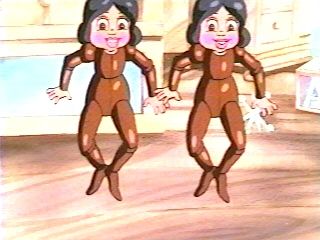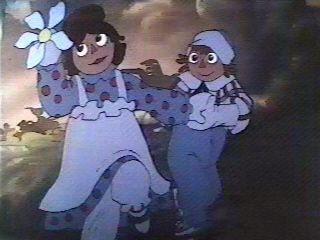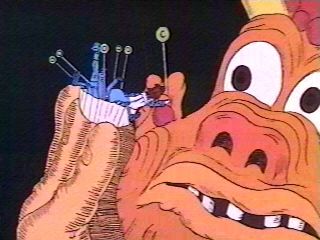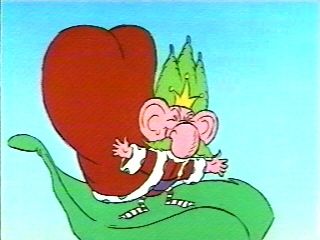
|
|
|
|
|
|
|
|
|
|
|
|
|
(1977) Director: Richard
Williams
Richard Williams has been called one of the most skilled animators of his time - maybe of all time. He certainly has the awards to back up this claim to fame; his 1958 animated short The Little Island won a BAFTA award, his 1972 animated rendition of A Christmas Carol won him an Academy Award, then a decade later his television production of Ziggy's Gift (which I feel is one of the best animated Christmas specials of all time) won an Emmy. Oh, and he added two more Oscars to his collection (a special achievement award and a Best Effects award) with his work on the animation in Who Framed Roger Rabbit (as well as another BAFTA award). He also recently published a book -The Animator's Survival Kit - that has been greatly acclaimed and is considered a godsend by both amateur and professional animators. However, it is likely that despite of all these awards
and various accolades Williams has received over the decades, you -
along with most other people - haven't heard of him. There are
certainly some reasons for In fact, just about everything Williams has ever done was not for the love of the particular assignment, but an attempt to raise money for that pet project of his. Instead of giving up on it and trying to get financing for other major projects (or settling for a career that would have him more or less be a director for hire), the direct focus on his studio was getting the movie completed, supporting itself and the project by being hired for low-profile work (like television commercials.) There was one other major project not previously mentioned that Williams worked on during this period for the money - directing the animated movie Raggedy Ann & Andy: A Musical Adventure. Originally, Williams signed up for the project just as an animation supervisor, with veteran Warner Brothers animation director Abe Levitow signed up to direct. But then when Levitow got ill and shortly afterwards died, the movie's backers put pressure on Williams to take over and direct, which he did so reluctantly. Possibly what convinced him to take on the task was the fact that he would be working directly with a considerable amount of talent - musician Joe Raposo (of Sesame Street and The Electric Company) would be writing the music and lyrics for the movie's songs, and the animators included seasoned professionals like Hal Ambro and Art Babbitt from Disney, and Looney Tunes animator Gerry Chiniquy. Despite all these people signed on, the
production was anything but smooth, due in part to enormous pressure
and the totally rigid demands the producers and financers placed on the
production team. It certainly didn't help that once again Even though this movie declares its star characters in its title, it's surprising that not only do we actually not get to know them that well in the actual movie, but that they really don't get to do that much. Sure, the movie shows them wandering from place to place, but when they get to a new place and situation, the focus is actually on the new place and situation, not on Ann and Andy reacting and adjusting to whatever new oddity they have found themselves with. They are more devices to take the movie from one place to another rather than actual characters. About all that we learn about them is that Andy keeps inside his pants a paper flower that his sister Ann gave him, and an equally disturbing song number where the two siblings constantly give each other big hugs while repeatedly declaring, "I love you!" The only way Ann and Andy ever get to show any charm and personality is indirectly, with their discover of The Camel With The Wrinkled Knees during their journey. Though the camel may be a paranoid schizophrenic plagued with hallucinations, one cannot be helped but be touched during his coherent moments when he laments being separated from his previous owner and now desperately looking for someone else to love him. Still, Raggedy Ann and Andy do end up looking a heck of
a lot better when you compare them to the other characters in the
movie. It's been a long time since I've seen so many characters in a
movie that are as obnoxious, physically repulsive, or who just don't
fit in the context like these ink-and-paint creations. Even though
Raggedy Ann & Andy is ostensibly aimed at Another problem with these characters is that not only are they annoying, we are forced to spend far more time with them than we actually have to. And for the most part, that minimum amount of time we have to spend with a particular character is actually zero. None of Ann and Andy's toymates (apart from Babette and the Pirate Captain) make any contributions of any consequence to the story. The long scene of Ann, Andy, and the Camel finding themselves entangled in the taffy sea of Greedy could easily be cut out of the movie with hardly any effort at all, since nothing happens in that has any effect of what subsequently happens in the movie. It's plain and simple padding, that's what it is, and so is all the focus on the movie's other characters. If you were to edit down the movie as much as you could while keeping the plot understandable, you would probably have a movie running 20 minutes, 30 minutes at the most. For the plot to movie just an inch forward, we first have to sit through several minutes of inconsequential talking - and singing. A lot of singing. A ton of singing. Just to give you an idea of the frequency of the song numbers, in the first 20 minutes of the movie there were five instances where the characters stopped to warble a song. It's exasperating how many times the movie finally starts to move a little, and wham, everything screeches to a halt for another number. Especially when the songs take several minutes to tell us things like "You're My Friend" and "It's Not Easy Being King When You're Short", which could easily be accomplished in a couple of lines of dialogue. As you might have guessed by now, the musical score is not one of Joe Raposo's finest accomplishments. However, I'll admit that a few of the songs, like "I'm Just A Rag Dolly" and "Candy Hearts And Paper Flowers", were very agreeable to listen to, and actually stuck in my head after the movie was over. It also helped that unlike almost all the other song numbers, these particular numbers were presented in a low-key tone; during their presentation, the characters slowed down their actions, and the rate of cuts to another angle went down considerably. Other than those two numbers, the singing and dancing often comes across as if someone dumped a big box of toys directly in your face - a big blur of different colored shapes swirling around. The movie was shot in Panavision, and with the full-frame version only available at my disposal, that might explain the confusion I experienced at these moments. Whether that was to blame, or if these scenes in fact generated the same feeling when shown uncompromised to moviegoers, I cannot say. Whatever the cause, I could only fairly judge the
animation when things weren't so Despite some nice moments, Raggedy Ann And
Andy: A Musical Adventure is still quite an ordeal to sit
through, and would probably only be of interest to die-hard animation
buffs, as well as professional animators interested in the work of
those esteemed in their circle. Though even they will find it tough
going for the most part, and may be embarrassed that a legendary figure
like Richard Williams directed it. Of course, it could be argued that
Williams didn't have his heart in the project, and was working under
the strict demands of the producers, which limited what he could do.
(Sources say that, among other things, Williams felt that there were
too many songs in the movie, but the producers forbid him to cut any
out.) On the other hand, much of what is considered "great art"
in the world was actually created from an arrangement where a patron
hired an artist to make a piece of art strictly following the demands
of the patron. That's how The Mona Lisa got made, and so was
how the ceiling of the Sistine Chapel got painted. So it could be
argued that even under the circumstances Williams could have done
better. What to think? I don't know about you, but I plan not to think
of Raggedy Ann And Andy: A Musical Adventure ever again. UPDATE: Seth Christenfeld sent this in: "A couple of years after the movie, Joe Raposo collaborated with the playwright William Gibson (who wrote, among many others, The Miracle Worker) on a musical about Raggedy Ann and Andy. Vague elements of the film's plot appear to have been used, as were several of the songs (although having no list of the songs from the film, I don't know which ones). The show was a massive bomb on Broadway (it ran five performances in 1986 - some info at http://www.ibdb.com/production.asp?ID=4425), but was apparently a success before that in Russia."
Check for availability on Amazon (VHS) See also: The Last Unicorn, Pinocchio In Outer Space, Tweety's High-Flying Adventure |
 this that Williams
cannot do anything about - for one thing, the copyright holders of The
Little Island, A Christmas Carol, and Ziggy Gift haven't
exactly been working hard to keep them in the public consciousness
since they were initially released. But if you ever get the opportunity
to learn of Williams' career in greater detail, you'll find that
Williams has often been his own greatest enemy. Time after time, (in
part due to his being a stickler for detail and his frequent bouts of
self-indulgence) he has gone over time and budget on a project, which
hasn't exactly endeared him to investors or people considering hiring
him, and naturally that has limited the number of major projects he's
ever been associated with. Another reason why he has not been as
prolific as other animators (even less talented ones like Don Bluth) is
because for the better part of his career he was obsessed with the
completion of his ill-fated animated movie The Thief And The
Cobbler, which he worked on for over 20 years.
this that Williams
cannot do anything about - for one thing, the copyright holders of The
Little Island, A Christmas Carol, and Ziggy Gift haven't
exactly been working hard to keep them in the public consciousness
since they were initially released. But if you ever get the opportunity
to learn of Williams' career in greater detail, you'll find that
Williams has often been his own greatest enemy. Time after time, (in
part due to his being a stickler for detail and his frequent bouts of
self-indulgence) he has gone over time and budget on a project, which
hasn't exactly endeared him to investors or people considering hiring
him, and naturally that has limited the number of major projects he's
ever been associated with. Another reason why he has not been as
prolific as other animators (even less talented ones like Don Bluth) is
because for the better part of his career he was obsessed with the
completion of his ill-fated animated movie The Thief And The
Cobbler, which he worked on for over 20 years. Williams went over
time and budget; reportedly he was removed from the project just before
it was finished. The finished product didn't exactly wow critics and
audiences when it was released, and it was quickly forgotten. How is it
more than twenty years later? Well, before getting into that, a brief
plot synopsis. This treatment of the beloved Johnny Gruelle characters
has rag-hag Ann and her boy-toy brother Andy as two of the many toys
owned by a little girl named Marcella. What Marcella doesn't know is
all of her toys are actually alive, coming to life whenever she goes
out of her room. The movie starts on Marcella's birthday, where she's
been given a new toy, which all the toys are eager to meet and
befriend. Did the makers of Toy Story see this movie?
Anyway, the new toy turns out to be a French doll named Babette, a
pompous and narcissist figure who does not realize she is a toy. Now
I'm pretty sure the makers of Toy Story did see
this movie, especially since not long after Babette gets introduced,
she exits out the window into the wild world outside, and Ann and Andy
take it upon themselves to go out the window themselves to try and
track her down. The only difference is that Babette doesn't get knocked
outside, but is instead kidnapped by Marcella's pirate captain doll,
who was immediately smitten by this newcomer at first sight.
Williams went over
time and budget; reportedly he was removed from the project just before
it was finished. The finished product didn't exactly wow critics and
audiences when it was released, and it was quickly forgotten. How is it
more than twenty years later? Well, before getting into that, a brief
plot synopsis. This treatment of the beloved Johnny Gruelle characters
has rag-hag Ann and her boy-toy brother Andy as two of the many toys
owned by a little girl named Marcella. What Marcella doesn't know is
all of her toys are actually alive, coming to life whenever she goes
out of her room. The movie starts on Marcella's birthday, where she's
been given a new toy, which all the toys are eager to meet and
befriend. Did the makers of Toy Story see this movie?
Anyway, the new toy turns out to be a French doll named Babette, a
pompous and narcissist figure who does not realize she is a toy. Now
I'm pretty sure the makers of Toy Story did see
this movie, especially since not long after Babette gets introduced,
she exits out the window into the wild world outside, and Ann and Andy
take it upon themselves to go out the window themselves to try and
track her down. The only difference is that Babette doesn't get knocked
outside, but is instead kidnapped by Marcella's pirate captain doll,
who was immediately smitten by this newcomer at first sight. the kiddie set,
there is a surprising amount of adult subtext attached to the sea
captain character, with his long moustache going erect at the sight of
Babette as well the area right above his groin visibly pulsing and
swelling. Sights such as those will probably go over the head of most
kids, but the utter repulsiveness of just about every character in the
movie may even annoy the typical child who is more accepting of movie
shortcomings than his parents. At one point the siblings meet "Greedy",
a gigantic living and breathing blob of taffy with an appetite and
table manners (including the constant generation of fart-like noises)
that makes Jabba The Hut look classy. Later on they meet "Sir Leonard
Looney", a knight in a land of crazy people, constantly executing
humiliating practical jokes with an attitude and a constant disturbing
laugh that suggests he has more of a deeply sick mind than one with any
idea of what genuine merriment is. Even Ann and Andy's playroom friends
have a creepy quality to them, the most disturbing being two twin
wooden marionettes who constantly do and say the same things together.
I couldn't stop thinking of the killer T-1000 in Terminator 2 whenever
I saw them.
the kiddie set,
there is a surprising amount of adult subtext attached to the sea
captain character, with his long moustache going erect at the sight of
Babette as well the area right above his groin visibly pulsing and
swelling. Sights such as those will probably go over the head of most
kids, but the utter repulsiveness of just about every character in the
movie may even annoy the typical child who is more accepting of movie
shortcomings than his parents. At one point the siblings meet "Greedy",
a gigantic living and breathing blob of taffy with an appetite and
table manners (including the constant generation of fart-like noises)
that makes Jabba The Hut look classy. Later on they meet "Sir Leonard
Looney", a knight in a land of crazy people, constantly executing
humiliating practical jokes with an attitude and a constant disturbing
laugh that suggests he has more of a deeply sick mind than one with any
idea of what genuine merriment is. Even Ann and Andy's playroom friends
have a creepy quality to them, the most disturbing being two twin
wooden marionettes who constantly do and say the same things together.
I couldn't stop thinking of the killer T-1000 in Terminator 2 whenever
I saw them. frenzied. Since this
movie was animated in the mid-'70s, you may have guessed that the
artwork lacks the polish found in animated features nowadays, and you
would be right. Typical for productions of the time, the Xerox method
was used, where pencil sketches the animators made were photocopied
directly onto the cels that were subsequently colored and photographed,
so as a result everything that is animated has that familiar "sketchy"
look to it. That's to be expected for the period, but what is a real
surprise is that even for the period the background artwork seems to
have had little care put into it, with its bland colors and visible
lack of detail. Despite these setbacks, the effort put in the animation
will impress many even today. Ann and Andy are drawn here with all
their baggy material intact, and despite all their detail we see them
twirl around, cartwheel, and somersault around with every thread of
theirs moving with a surprising fluidity. Ann and Andy's animation
isn't the only time where I'm sure the animators kept screaming with
agony at their sketchboards. Though Greedy is a disgusting character,
even I must admit a lot of work went into creating this ever-shifting
ocean of taffy, though eventually it gets so twisted you have to wonder
if the animators took drugs stronger than Ex-Lax and Peptol-Bismol. The
whole Kookoo land sequence has some strong use of colors and odd
shapes, as well as some striking visuals. In fact, Williams must have
been equally impressed by some of these visuals, because they are
virtually alike to some found in The Thief And The Cobbler.
frenzied. Since this
movie was animated in the mid-'70s, you may have guessed that the
artwork lacks the polish found in animated features nowadays, and you
would be right. Typical for productions of the time, the Xerox method
was used, where pencil sketches the animators made were photocopied
directly onto the cels that were subsequently colored and photographed,
so as a result everything that is animated has that familiar "sketchy"
look to it. That's to be expected for the period, but what is a real
surprise is that even for the period the background artwork seems to
have had little care put into it, with its bland colors and visible
lack of detail. Despite these setbacks, the effort put in the animation
will impress many even today. Ann and Andy are drawn here with all
their baggy material intact, and despite all their detail we see them
twirl around, cartwheel, and somersault around with every thread of
theirs moving with a surprising fluidity. Ann and Andy's animation
isn't the only time where I'm sure the animators kept screaming with
agony at their sketchboards. Though Greedy is a disgusting character,
even I must admit a lot of work went into creating this ever-shifting
ocean of taffy, though eventually it gets so twisted you have to wonder
if the animators took drugs stronger than Ex-Lax and Peptol-Bismol. The
whole Kookoo land sequence has some strong use of colors and odd
shapes, as well as some striking visuals. In fact, Williams must have
been equally impressed by some of these visuals, because they are
virtually alike to some found in The Thief And The Cobbler.